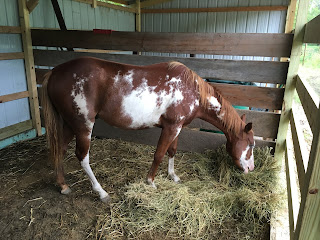- Trailer
- Enclosed Area
The Goal: The horse associates the trailer with something
“good” (food). The horse accepts your presence in the trailer with him.
Once the trailer is secured, the back door of the trailer
should be left open. If it is a slant
load trailer, the partitions should be removed or secured open so that the
horse has as much room as possible. All
of the horse’s food should be placed inside the trailer. For some horses that are especially wary of
the trailer, the food may have to be placed closer to the opening for the first
few days. The horse should be allowed to
go in and out of the trailer as he pleases.
Do not offer any food except what is inside the trailer. It is normal in the beginning for the horse
to grab a bite of hay and quickly exit the trailer and eat it outside. Eventually he should relax and be able to eat
his food inside the trailer. Continue to
feed the horse in the trailer until the horse seems relaxed.
Training Plan Example:
Day 1: Place the food inside the trailer where the horse can
just barely reach it by stretching out his neck.
Day 2: Place the food where the horse must put both front
feet into the trailer.
Day 3: Place the food where the horse must put all four feet
into the trailer.
Day 4: Place the food at the very front of the trailer.
Next, the horse must learn to accept your presence in the
trailer with him. Using grain at this
step can be helpful. The grain should
only be available when you are standing in the trailer. For some horses, you may have to start back
at Day 1 with placing the grain so the horse can just barely reach it without stepping
in the trailer. Each day, move the grain
farther into the trailer until you can stand next to your horse all the way
inside the trailer while he eats his grain.
Once your horse is relaxed with you in the trailer and
willingly stands inside the trailer for extended periods of time, you can move
to Step 2!
Case Study: Zeke
I began Step 1 with Zeke last fall. The
first day, Zeke spent very little time in the trailer, especially when I was close
enough where I could have shut the door.
He went in, grabbed a bit of hay, and jumped out to chew the hay. Over the next several days, he spent more
time in the trailer and was less concerned when I was nearby. By the end of the week, I was able to stand
in the trailer with him. I ended up having
to use the trailer about a week later and never got around to parking it back
in his pen.
When I got the trailer back out this spring, I started back
at Step 1. As soon as I opened the round
pen gate, Zeke jumped into the trailer.
This was a really great sign that he remembered the food reward from
last fall and was not concerned about the trailer being there. He readily accepted my presence with him in
the trailer and we moved on to Step 2.








